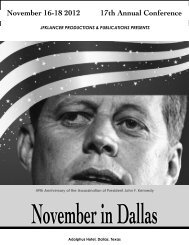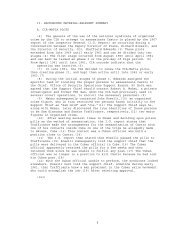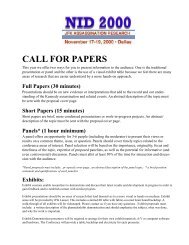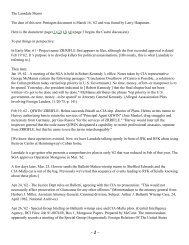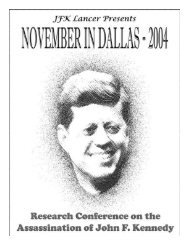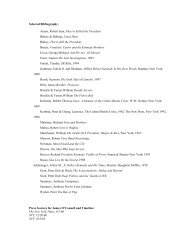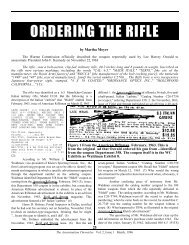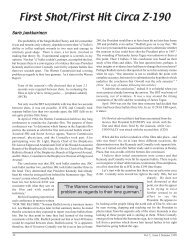THE SECRET SERVICE AGENT ON THE KNOLL - JFK Lancer
THE SECRET SERVICE AGENT ON THE KNOLL - JFK Lancer
THE SECRET SERVICE AGENT ON THE KNOLL - JFK Lancer
You also want an ePaper? Increase the reach of your titles
YUMPU automatically turns print PDFs into web optimized ePapers that Google loves.
<strong>THE</strong> <strong>SECRET</strong> <strong>SERVICE</strong> <strong>AGENT</strong><br />
<strong>ON</strong> <strong>THE</strong> <strong>KNOLL</strong><br />
by Debra Conway,<br />
with contributions from Michael Parks<br />
Copyright 2001<br />
“After the assassination, several witnesses stated<br />
they had seen or encountered Secret Service agents<br />
behind the stockade fence situated on the grassy knoll<br />
area and in the Texas School Book Depository.” (HSCA<br />
Report pg. 184)<br />
Introduction:<br />
I suppose the first thing most researchers think when<br />
reading about Officer Smith’s experience meeting the<br />
Secret Service Agent on the knoll is to wonder who it could<br />
have been, the second thought has to be, “What nerve!” The<br />
creativity of impersonating one of the Presidential Praetorian<br />
Guard is one that always stood out in my mind. Our guy is<br />
not content with the everyday impersonation of Dallas’ finest<br />
or the cache of being an FBI agent. (And CIA agents<br />
never identify themselves as such so that was out of the<br />
question.) But to claim be one of the elite Secret Service,<br />
those men with sunglasses and headsets in their ears – albeit<br />
in this case, with dirty fingernails and a sportcoat. 1<br />
According to assassination literature and testimony it<br />
has long been established that no genuine Secret Service<br />
agents were in Dealey Plaza until later in the afternoon of<br />
November 22, 1963. Surprisingly, not only were there no<br />
Secret Service agents assigned to or stationed behind the<br />
grassy knoll area, but there were no FBI or other federal<br />
agents, or Dallas Police Officers stationed there either. This<br />
fact suggests phony Secret Service agents were in Dealey<br />
Plaza, and that perhaps they were there to help the assassins<br />
escape.<br />
I began my search for the knoll agent a few years ago<br />
when an article written by Warren Commission apologist<br />
Max Holland for The Washington Spectator newsletter stated<br />
that the mysterious agent on the knoll was none other than<br />
James W. Powell, a Army Intelligence agent on his day off.<br />
“James Powell, an Army Intelligence agent then<br />
involved in the surveillance of domestic dissidents, was<br />
present, and dressed in civilian clothes, in the Texas<br />
School Book Depository building in Dallas, 10 minutes<br />
after the shooting. And his unit, 112th Intelligence<br />
Group, did indeed have a file on a self-styled, and<br />
seemingly non-violent, Marxist named Lee Harvey<br />
Oswald....Like thousands of Dallasites that bright<br />
November day, Powell had taken the day off to watch<br />
the President and First Lady....After hearing the shots,<br />
Powell, who was a block away from Dealey Plaza,<br />
immediately ran to the vicinity. His first reaction was<br />
to take a picture of the TSBD because several people<br />
were pointing to it as the source of the rifle fire. He<br />
then raced over to check out the commotion around the<br />
“grassy knoll,” identifying himself as “Special Agent<br />
Powell,” and thereby creating rumors of a mysterious<br />
federal agent at the seen.” (The Washington Spectator,<br />
May 15, 1997)<br />
After reading this article, I first called the ARRB’s<br />
Washington, D.C. offices to ask when the Powell statement<br />
had been taken and when it had been released. I related that<br />
I had read a summary of the interview by Holland and astonishingly<br />
was told it wasn’t released yet. I then phoned<br />
The Washington Spectator contacting Mr. Holland who<br />
openly admitted his source was an ARRB staffer who shared<br />
the statement with him. I was understandably upset and<br />
shortly received a call back from both the ARRB’s Information<br />
Officer, Tom Samoluk and General Council, Jeremy<br />
Gunn. Gunn told me that Powell didn’t necessarily admit he<br />
was the agent on the knoll, it was the staffer’s interpretation<br />
of the conversation — not necessarily what the testimony<br />
says.<br />
Confusingly, after pestering the ARRB and NARA the<br />
following years for both the Robert E. Jones HSCA testimony<br />
and the ARRB’s Powell statement, finally on May 24,<br />
1999, I was sent three pages of the HSCA’s Executive Session<br />
questioning of Army Intelligence Col. Robert E. Jones 2 ,<br />
but not the ARRB’s Powell statement. I finally received that<br />
document a year later simply faxed to me from the National<br />
Archives. 3<br />
Through the years there has been speculation from different<br />
assassination related sources regarding the knoll agent.<br />
There is no doubt he was there on the grassy knoll only moments<br />
after the shooting. More than a few authors have<br />
scoured testimony and written many words speculating on<br />
who the knoll agent could have been. This article won’t tell<br />
you that but it will tell you who it wasn’t.<br />
To assist the reader with the purpose of this article I<br />
begin with a listing of the witnesses to the knoll agent and<br />
their statements:<br />
Kennedy Assassination Chronicles 17
<strong>THE</strong> WITNESSES<br />
Dallas Police Officer Joseph Smith<br />
“After the shooting, Dallas Police officer Joe M. Smith<br />
encountered another suspicious man in the lot behind<br />
the picket fence [on the grassy knoll]. Smith told the<br />
Warren Commission that when he drew his pistol and<br />
approached the man, the man “showed [Smith] that he<br />
was a Secret Service agent.” (WC Vol. VII, pg. 535;<br />
see interview of Joseph M. Smith, Feb. 8, 1978, House<br />
Select Committee on Assassinations (<strong>JFK</strong> Document<br />
005886).)<br />
“I looked into all the cars and checked around the<br />
bushes. Of course, I wasn’t alone. There was some<br />
deputy sheriff with me, and I believe one Secret Service<br />
man when I got there. I got to make this statement, too.<br />
I felt awfully silly, but after the shot and this woman, I<br />
pulled my pistol from my holster, and I thought, this is<br />
silly, I don’t know who I am looking for, and I put it<br />
back. Just as I did, he showed me that he was a Secret<br />
Service agent.” (Warren Commission Hearings, Vol.<br />
VII, pg.. 531)<br />
J.C. Price<br />
Post Office employee Price was never called to testify,<br />
however, he did sign an affidavit stating that immediately<br />
after the shots he saw a man with something in his right<br />
hand run across the railroad yard that lies behind the wooden<br />
fence and parking area.<br />
“I saw one man run towards the passenger cars on the<br />
railroad siding after the volley of shots. This man had a<br />
white dress shirt, no tie and khaki colored trousers. His<br />
hair appeared to be long... He had something in his<br />
hand. I couldn’t be sure but it may have been a head<br />
piece.” (Dallas Sheriff’s Department Affidavit, 12-22-<br />
63)<br />
Lee Bowers, Jr.<br />
Bowers, from his vantage point in the train observation<br />
tower located in the parking lot behind the Texas School<br />
Book Depository, saw two strangers standing near the<br />
wooden fence prior to and at the time of the shooting. They<br />
fit the description of the casually dressed man who accosted<br />
Officer Smith. (WC Vol. Dallas, Tex. by Mr. Joseph A. Bail,<br />
assistant counsel of the President’s Commission.<br />
“One man, middle-aged, or slightly older, fairly heavyset,<br />
in a white shirt, fairly dark trousers. Another<br />
younger man, about midtwenties, in either a plaid shirt<br />
or plaid coat or jacket. They were standing within 10 or<br />
15 feet of each other, and gave no appearance of being<br />
together, as far as I knew. They were facing and looking<br />
up towards Main and Houston, and following the<br />
caravan as it came down.”<br />
Sam Holland<br />
Holland told the Warren Commission that he ran around<br />
behind the fence on the knoll immediately after the shots<br />
and saw evidence of someone standing behind the fence —<br />
muddy footprints going back and forth in one spot. He mentions<br />
seeing “agents” a few minutes later.<br />
“...I remember about the third car down from this fence,<br />
there was a station wagon backed up toward the fence,,,<br />
a spot, I’d say 3 foot by 2 foot, looked to me like<br />
somebody had been standing there for a long time.<br />
“Yes; immediately, but I turned around, see, and went<br />
to searching in there for empty shells, and three or four<br />
agents there then and that is when I walked back to the<br />
ear there and noticed the tracks there in one little spot.”<br />
(WC Vol. 6, pgs. 254-247)<br />
Malcolm Summers<br />
“I ran across the—Elm Street to right there toward the<br />
knoll. It was there [pointing to a spot on the knoll]—<br />
and we were stopped by a man in a suit and he had an<br />
overcoat—over his arm and he, he, I saw a gun under<br />
that overcoat. And he—his comment was, “Don’t you<br />
all come up here any further, you could get shot, or<br />
killed,” one of those words. A few months later, they<br />
told me they didn’t have an FBI man in that area. If they<br />
didn’t have anybody, it’s a good question who it was.”<br />
(1988 documentary Who Murdered <strong>JFK</strong>?)<br />
Ed Hoffman<br />
“A police officer came around the north end of the fence.<br />
He saw and confronted the suit man. The policeman<br />
held his service revolver in both hands, arms extended<br />
forward, legs spread and slightly squat. The suit man<br />
held both arms out to his side, as if to gesture, ‘it wasn’t<br />
me. See, I have nothing.’ Then the suit man reached<br />
inside his coat and pulled out something and showed it<br />
to the police officer. The officer relaxed, and both men<br />
mingled with the crowd coming around the fence.”<br />
(Eyewitness, by Ed Hoffman and Ron Friedrich, 1998)<br />
18<br />
Vol. 6, Issue 4 Winter 2000
officer who pointed a pistol at him and shouted ‘Where<br />
are you going?’ He then returned down the slope.”<br />
(Letter from December 5, 1966)<br />
Baetz mentioned the ecent publicity: LIFE<br />
November 25, 1966<br />
Gordon Arnold<br />
After hearing the shots, “The next thing I knew someone<br />
was kicking my butt and telling me to get up, Arnold<br />
said, ‘It was a policeman. And I told him to go jump in<br />
the river. And then this other guy — a policeman —<br />
comes up with a shotgun and he was crying and that<br />
thing was waving back and forth.” (Dallas Morning<br />
News, August 27, 1978, under the caption, “SS Imposters<br />
Spotted by <strong>JFK</strong> Witness,” by reporter Earl Golz.)<br />
Another Witness?<br />
Wilfred Baetz<br />
According to documents found by Michael Parks, Mark<br />
Colgan and myself, Wilfred Baetz saw the November 25,<br />
1966, LIFE Magazine and decided to admit he had been in<br />
Dealey Plaza on the day of the <strong>JFK</strong> assassination. 3 According<br />
to a letter summarizing Baetz’s phone statement on December<br />
5, 1966, written by Charles Batchelor, Dallas Chief<br />
of Police, Baetz called both the New York FBI and Chief<br />
Batchelor. On December 7, 1966, Chief Batchelor sent this<br />
letter to the Dallas FBI office. (Document 1, pg. 22 of this<br />
article) But by the time the New York FBI pays him a visit<br />
Baetz has changed his mind and denies not only being in<br />
Dealey Plaza and being accosted by the Secret Service man,<br />
he denies even making the calls in the first place. Why? Perhaps<br />
the second document holds the explanation: Baetz’s<br />
wife works for TIME-LIFE. (Document 2, pg. 22 of this article)<br />
“The subject stated...He was standing on the grass on<br />
the north side of Elm Street — on the slope approaching<br />
the triple underpass. He recalls only one shot and<br />
immediately after the shot he ran up the slope toward<br />
the railroad tracks and was stopped by an unknown<br />
Is this a valid witness? After reading the background<br />
report listing some of Mr. Baetz’s more colorful past experiences,<br />
he may not be considered a strong one. However,<br />
the evidence shows he could not have made the claim of<br />
seeing the knoll agent without having actually experienced<br />
it. The “recent publicity” he relates to when contacting the<br />
FBI is a LIFE Magazine issue concerning the Zapruder film<br />
— not witness statements. Likewise, the phone call to the<br />
FBI did originate from his home where he admits no one<br />
else could have had access.<br />
Each witnesses’ statement leaves us with the unimpeachable<br />
conclusion that there was a man on the grassy<br />
knoll moments after the shooting identifying himself verbally<br />
and physically (showing the badge) as Secret Service. 4<br />
Next we must try to find out who it could have been.<br />
Potential Agents<br />
Secret Service<br />
• Agent Lem Johns<br />
• Agent Forrest Sorrels<br />
Committee interviews or depositions with 11 of the 16<br />
agents who were on duty with the motorcade and with<br />
their supervisors produced evidence that only one agent<br />
had left the motorcade at any time prior to the arrival<br />
at Parkland Hospital. This agent, Thomas “Lem” Johns,<br />
had been riding in Vice President Johnson’s follow-up<br />
car. In an attempt to reach Johnson’s limousine, he had<br />
left the car at the sound of shots and was momentarily<br />
on his own in Dealey Plaza, though he was picked up<br />
almost immediately and taken to Parkland Hospital. 5<br />
In every instance, therefore, the committee was able to<br />
establish the movement and the activities of Secret<br />
Service agents. Except for Dallas Agent-in-Charge<br />
Sorrels, who helped police search the Texas School Book<br />
Depository, no agent was in the vicinity of the stockade<br />
fence or inside the book depository on the day of the<br />
assassination. (HSCA Report pg. 184)<br />
Dallas Police<br />
• Plainclothes Detectives<br />
Because the Dallas Police Department had numerous<br />
plainclothes detectives on duty in the Dealey Plaza area,<br />
the committee considered it possible that they were<br />
mistaken for Secret Service agents. (HSCA Report, pg.<br />
185)<br />
Kennedy Assassination Chronicles 19
20<br />
Vol. 6, Issue 4 Winter 2000
According to Dallas Police records no plainclothes<br />
detectives were assigned to the knoll area in Dealey Plaza 6 .<br />
But if there, the question begs to be asked: “Why would they<br />
identify themselves as Secret Service?” Were they behind<br />
the fence on the grassy knoll? Not officially.<br />
Alcohol, Tobacco, and Firearms Bureau (A&TT)<br />
• Frank Ellsworth<br />
“...[FBI Agent James] Hosty told the [House] Select<br />
Committee that at the time of the assassination ‘Frank’<br />
Ellsworth...had indicated that he had been in the grassy<br />
knoll area and for some reason identified himself as a<br />
Secret Service Agent.’ 7 Ellsworth, deposed by the<br />
Committee, denied Hosty’s allegation. 8 We know,<br />
however, that he was in the immediate area.<br />
Interestingly, he and seven other ATF agents were among<br />
the first law enforcement personnel of any description<br />
to reach the sixth floor of the TSBD. If Ellsworth was in<br />
the vicinity, it remains to be asked how Hosty knew about<br />
it. (Peter Dale Scott, Deep Politics, pg. 274)<br />
“In 1963, if you would have asked me if I was a Secret<br />
Service agent, I most likely would have answered yes—<br />
our roles overlapped that much.” (Frank Ellsworth to<br />
author Gus Russo in 1994, Live By The Sword, pg. 473)<br />
Is Ellsworth admitting he is the knoll agent? If so, then<br />
why did he deny it to the HSCA? Reflecting on the timing of<br />
Officer Smith seeing the knoll agent, if Ellsworth left his<br />
fellow agents and drifted over to the knoll area immediately<br />
after the shooting he may have been the man Smith saw.<br />
According to testimony, this didn’t happen.<br />
• Other ATF Agents<br />
The text below is from a US Secret Service document<br />
given to <strong>JFK</strong> <strong>Lancer</strong> by author Gus Russo regarding a memo<br />
from Alcohol and Tobacco Tax regarding their agents in<br />
Dealey Plaza on the day of the assassination. 9 (A&TT was<br />
the old name of ATF.) Both ATF and Secret Service had treasury<br />
ID’s. Even so, the Booth documents state the agents<br />
were searching the TSBD, not the knoll. 10<br />
CO-2-34,030<br />
U.S. <strong>SECRET</strong> <strong>SERVICE</strong><br />
TO: Chief - Attn. Inspr. Kelly<br />
FROM: SAIC Sorrels, Dallas (initialed)<br />
SUBJECT: Report as to A&TT Investigators searching<br />
Texas School Book Depository Bldg., Dallas, TX, after<br />
assassination of President Kennedy.<br />
There is enclosed a memorandum dated Jan. 14, 1964,<br />
submitted by Mr. Carl R. Booth, Jr. Supervisor in<br />
Charge, Alcohol and Tobacco Tax, Dallas, TX, regarding<br />
their Special Investigators and others having assisted<br />
in search of the Texas School Book Depository Building<br />
after assassination of President Kennedy on Nov. 22,<br />
1963. A copy of this memorandum is being retained in<br />
Dallas office.<br />
ATTACHMENT - Memo & cc.<br />
-=-=-<br />
Army Intelligence<br />
Any study of Army Intelligence in Dealey Plaza must<br />
begin with the amazing testimony of Col. Robert Jones before<br />
the HSCA. 11 Excerpted below, Jones, in 1963 was commanding<br />
officer of the military intelligence region that encompassed<br />
Texas called the 112th. Did Military Intelligence<br />
personnel identify themselves as Secret Service agents on<br />
the grassy knoll?<br />
The committee did obtain evidence that military<br />
intelligence personnel may have identified themselves<br />
as Secret Service or that they might have been<br />
misidentified as such. Robert E. Jones... told the<br />
committee that from 8 to 12 military intelligence<br />
personnel in plainclothes were assigned to Dallas to<br />
provide supplemental security for the President’s visit.<br />
He indicated that these agents had identification<br />
credentials and, if questioned, would most likely have<br />
stated that they were on detail to the Secret Service.<br />
The committee sought to identify these agents so that<br />
they could be questioned. The Department of Defense,<br />
however, reported that a search of its files showed “no<br />
records...indicating any Department of Defense<br />
Protective Services in Dallas.” The committee was<br />
unable to resolve the contradiction. (HSCA Report, pg.<br />
184)<br />
Testimony of Colonel Robert Jones<br />
Mr. Genzman: Colonel Jones, I next would like to ask<br />
you about the liaison operations between military<br />
intelligence and the Secret Service.<br />
Mr. Jones: At any time that the President, or Vice<br />
President, or anyone at the Secret Service has<br />
responsibility for physical protection, would be<br />
scheduled to arrive in the area, they would contact our<br />
Group Headquarters or our Regional Headquarters and<br />
we would augment their force, if necessary to provide<br />
some type of physical coverage, that is, a man on the<br />
street, or an observation of people, vehicles,<br />
Kennedy Assassination Chronicles 21
22<br />
communications, or any other information or support<br />
that we could provide.<br />
But in every case, to my knowledge, our people were<br />
under the control and supervision of Secret Service. We<br />
never assumed responsibility for the President’s<br />
protection.<br />
Mr. Genzman: Would you characterize these operations<br />
as supplementing the manpower of the Secret Service?<br />
Mr. Jones: Yes, I would.<br />
Mr. Genzman: With specific reference to President<br />
Kennedy’s trip to Texas, would you release to the<br />
committee your connection with liaison operations with<br />
the Secret Service?<br />
...<br />
Mr. Jones: We provided a small force — I do not recall<br />
how many, but I would estimate between 8 and 12 —<br />
during the President’s visit to San Antonio, Texas, and<br />
then the following day, on his visit to Dallas, the regions<br />
also provided additional people to assist, that is<br />
additional people from Region 2.<br />
Mr. Genzman: Did these people which you provided<br />
include sources who were in contact with the various<br />
local law enforcement agencies?<br />
Mr. Jones: The people who were in contact with either<br />
the intelligence division or the State Police or the Police<br />
Department or the FBI or Secret Service, were reporting<br />
either directly to me or to the Regional Operational<br />
Officer if necessary, or to the FBI, but it was normally<br />
channeling through the region or to the group<br />
headquarters. This information would then be made<br />
available to the requesting investigating agency.<br />
...<br />
Mr. G.: I have several other names I would like to ask<br />
you about. Was James W. Powell one of these liaison<br />
personnel?<br />
Mr. J.: Yes, he was a Captain and also wore civilian<br />
clothes and was assigned to Region 2 of the 112 MI<br />
Group.<br />
Mr. G.: Was he, in fact, on duty the day of the<br />
assassination?<br />
...<br />
Mr. J: Yes he was.<br />
...<br />
Mr. G.: Colonel Jones, I would like clarify several points.<br />
How many people did the Department of Defense<br />
Intelligence have on duty assisting the Secret Service in<br />
Dallas on the day of the assassination?<br />
Mr. J.: I would estimate between eight and twelve.<br />
Mr. G.: How many of these people would have been in<br />
plain clothes?<br />
Mr. J.: All of them.<br />
Mr. G.: Would any of these Military Intelligence<br />
personnel have been carrying Secret Service credentials<br />
as a part of their liaison work with the Secret Service?<br />
Mr. J.: They would have not have been carrying Secret<br />
Service credentials. They would have been identified<br />
with some type of sign, or something on their lapels, or<br />
some code or communication that could be identified<br />
in the crowd.<br />
This was handled by the Secret Servicemen and they<br />
would always advise our people on the type of signal or<br />
sign to wear, but they did not have Secret Service<br />
credentials.<br />
-end of excerpt-<br />
(Executive session testimony of Col. Robert E. Jones,<br />
April 20, 1978, House Select Committee on<br />
Assassinations (<strong>JFK</strong> Classified document 014677. 3 )<br />
Remember, this is the same Robert E. Jones, operations<br />
officer of the U.S. Army’s 112th Military Intelligence<br />
Group Fort Sam Houston, Texas, who contacted the FBI offices<br />
in San Antonio and Dallas and gave those offices detailed<br />
information concerning Oswald and A. J. Hidell,<br />
Oswald’s alleged alias, from the Army Intelligence files. The<br />
HSCA rightly felt this information suggested the existence<br />
of a military intelligence file on Oswald and raised the possibility<br />
that he had intelligence associations of some kind.<br />
Jones was directly responsible for counterintelligence operations,<br />
background investigations, domestic intelligence,<br />
and any special operations in a five-state area. (HSCA Report,<br />
pg. 221-222)<br />
When the Oswald military intelligence file was requested<br />
by the House Committee, the Department of Defense<br />
relayed that they “destroyed the file as part of a general<br />
program aimed at eliminating all of its files pertaining<br />
to nonmilitary personnel.” (HSCA Report, pg. 223; Letter<br />
from Department of Defense to House Select Committee on<br />
Assassinations, June 22, 1978, pg. 6 )<br />
James W. Powell<br />
James Powell is important in assassination research for<br />
several reasons. According to his ARRB statement Powell<br />
Vol. 6, Issue 4 Winter 2000
had been in Dealey Plaza when the shooting occurred and<br />
had taken several photographs with a 35mm Minolta camera.<br />
One, of course, is his famous photograph of the Texas<br />
School Book Depository taken just seconds after the shooting<br />
of the president which shows the full length of the TSBD.<br />
It was released by the FBI in 1976 and first published in an<br />
assassination book 12 . None of the other Powell photos have<br />
ever been published and he has rarely been interviewed.<br />
Let’s return to the beginning of this article with the<br />
ARRB’s interview of Powell by Timothy A. Wray, ARRB<br />
chief Analyst for Military Records. 13 What does Powell say<br />
about his activities on November 22, 1963?<br />
His background:<br />
Wray: And what was the nature of your duties (at the<br />
time of the assassination)?<br />
Powell: Well, I was a member of the 112 th INTC<br />
(Intelligence Corps) Group. I ran security investigations<br />
for security clearances on both military and civilian<br />
personnel that worked, for instance, on missile bases<br />
or wherever. As long as some part of their life was in<br />
our area: Dallas, Texarkana, Amarillo, that sort of thing.<br />
I’d be responsible for checking into their background.<br />
Checking possibly police records. I went out<br />
interviewing references they might have given, character<br />
references, and developing additional character<br />
references from those that were given by the people we<br />
were running the security clearances on.<br />
Wray: Okay. Now, just to mention some things here that<br />
I think are already in the record. Ordinarily you did<br />
your, you performed your duties in civilian clothes?<br />
Powell: Correct.<br />
…<br />
Wray: You had some kind of identification credential,<br />
didn’t you, separate from your military ID card, that<br />
identified you as a special agent?<br />
Powell: Yes.<br />
Wray: Something like this? [Wray shows Powell his<br />
ARRB identification, which is a bifold wallet-type<br />
credential showing owner’s picture and employing<br />
federal agency.]<br />
Powell: …something in your pocket you opened up. Like<br />
that exactly. [Laughs] And there you are, Mr. Wray.<br />
Exactly.<br />
…<br />
Wray: In the files that I’ve been able to search, I saw<br />
the immediately after the assassination you wrote a<br />
memorandum, and you may have been interviewed by<br />
some other people, FBI or something like that. But an<br />
indication that you also were interviewed by some people<br />
for, I think, the Church Committee – that was the Senate<br />
committee on intelligence – in approximately 1973.<br />
Later the House Select Committee on Assassinations<br />
had a couple of people talk to you. Is that correct?<br />
Wray: You also had special training in photographic<br />
investigation?<br />
Powell: Right, investigative photography.<br />
Wray: How did that play in your duties? Or was it just<br />
an additional skill you didn’t use that very much?<br />
Powell: It was primarily an additional skill. It was like<br />
anything else you do in the military, you get trained for<br />
it in the event that you have to use it someday. We were<br />
trained in investigative photography, both from the<br />
standpoint of taking actual pictures of – well, let’s say<br />
we were expected to go out and photograph spies, or<br />
whatever, or follow suspected people that we were<br />
suspicious of doing something involved with the military<br />
against us. We were trained to be able to seek these<br />
people out, to photograph, to cover, to do surveillance<br />
on them, that type of thing. I was trained to do the<br />
photographic end of that, not only from the standpoint<br />
of taking pictures but developing them as well.<br />
Powell: The House Select Committee I remember. I<br />
don’t…maybe the other one also on the phone. I don’t’<br />
remember a direct interview with them. But the House<br />
Select Committee people did come out here to Los<br />
Angeles and I met them in a hotel in downtown L.A.<br />
Couple of gentlemen. The identified themselves and I<br />
talked with them, and I got correspondence back from<br />
them sort of confirming our meeting and so forth.<br />
The events of November 22 nd :<br />
Wray: Let me turn now to the events around the 22 nd of<br />
November, 1963. Do you recall when or how you learned<br />
that the President was going to visit Dallas? Did you<br />
learn the day before, two days before, a week before, a<br />
month before? Do you have any impression of how long<br />
you learned about this?<br />
Powell: To be very honest with you, no. I’m sure like<br />
everyone else I read it in the paper and heard about it.<br />
It was interesting enough that I asked for time off, a<br />
leave of absence from my regular duties so I could see<br />
the motorcade, so I could go out to the airport and see<br />
Kennedy Assassination Chronicles 23
24<br />
the president. And I was hoping to get a few pictures.<br />
But I don’t remember specifically how long before. I’d<br />
say in the neighborhood of a week, probably.<br />
Wray: do you recall any discussion with other members<br />
of the 112 th in anticipation of the presidential visit? Other<br />
people that were going to try to get time off to go see it,<br />
or anything else that anybody was going to be doing in<br />
connection with that? With the visit?<br />
Powell: To be very hones with you, no. That’s surprising<br />
when I think about it. I know others were there, they<br />
were on duty, or they were working the normal things<br />
that they do and did not ask for time off to do this.<br />
Wray: Do you recall any discussion, or activities the<br />
112 th was going to do related to providing security for<br />
the President?<br />
Powell: No. Not at all.<br />
Wray: Do you recall any occasion previous to that, or<br />
for that matter subsequent to that, when the 112 th did<br />
provide any kind of security – if not for the President,<br />
for any other kind of activity?<br />
Powell: We did not.<br />
Wray: Okay, now you mentioned that on the 22 nd of<br />
November that you had asked for time off. I understand,<br />
I’m just clarifying something here. Some members of<br />
the unit were still – maybe most members of the unit –<br />
were working that day. Is that correct? But you had<br />
specifically asked for time off?<br />
Powell: Right. Because if you’re… In my capacity I’m<br />
expected to be out – I have leads that are given to me.<br />
When I’m given a lead, I’m expected to go out and<br />
interview references and look for records and that type<br />
of thing during the course of the day, and then file a<br />
report on each one of those. That’s what the other agents<br />
were doing except for those that, there was always a<br />
staff in the building – in this case the Rio Grande<br />
Building 14 – and there were probably three or four of<br />
those people there at the time when I had my time off.<br />
The other agents were just out doing their regular job.<br />
Wray: Let’s go over here, sort of what happened that<br />
day. Did you go, do you recall whether you went to the<br />
office that day before you went out to Love Field? I<br />
mean, you were on pass that day, so…<br />
Powell: No.<br />
Wray: Did not go to the office?<br />
Powell: No need to.<br />
Wray: So you went to Love Field. Were you there for<br />
when the President initially arrived?<br />
Powell: Yes. Yes.<br />
Wray: And did you take pictures at that time?<br />
Powell: Yes, I did.<br />
Wray: And how many pictures?<br />
Powell: Not many. Probably three or four as they came<br />
off the plane. And I was a pretty good distance away,<br />
and unfortunately without a telescopic lens. [Laughs]<br />
You see these very small people coming off this great<br />
big plane…<br />
Events in Dealey Plaza:<br />
Powell: I know exactly where I was. He’d come down<br />
Main Street…turned right onto Houston and left<br />
essentially on Elm and then down under the freeway.<br />
When I took the pictures I was back here – again, I<br />
honestly can’t remember if these things have published<br />
the main streets, but it was one of the east-west streets.<br />
The motorcade was coming down, I was approximately<br />
a block away, over here which is off this sketch… taking<br />
photographs of the motorcade as it went by. Once it<br />
went by me…I was on Main because I went one block<br />
back to Elm Street and I was coming down this way and<br />
I was almost at this intersection when the motorcade<br />
came around and started down Elm Street, down the<br />
hill. I was probably half way down the block when I<br />
heard the shots fired. At that time, not expecting anything<br />
like that, you weren’t sure if we had backfires going on<br />
or fireworks or actual shots. Obviously, it turns out that<br />
shots were fired.<br />
Wray: In terms of distance, how far would you estimate<br />
you were from the intersection of Elm and Houston then?<br />
Powell: Maybe a hundred feet.<br />
…<br />
Powell: I knew that when I got to this intersection, there<br />
were people pointing up at the Book Depository Building<br />
indicating that they had heard shots coming from there.<br />
Wray: If I could ask you, when you say “people,” you<br />
mean more than one person?<br />
Vol. 6, Issue 4 Winter 2000
Powell: People. Yes. More than one person: A couple.<br />
At least one pointed up at the building, and another<br />
standing near that person – I think this gentleman<br />
corroborated that. I crossed the street over to the Book<br />
Depository Building and walked on down. There were,<br />
there were police officers, a few police officers there<br />
that had just been around the area, plus some – at least<br />
a couple – from the sheriff’s department that were there.<br />
Sheriffs. In group we kind of went to the parking area<br />
behind because there were, again, a lot of civilians<br />
standing around watching the motorcade coming down<br />
who’d said they thought they heard, that they thought<br />
they’d heard someone running through that area. So<br />
we all went together back there but didn’t see anything<br />
obvious, other than just this stampede. Nobody carrying<br />
a gun or anything like that. So I left the group and went<br />
back to the Book Depository Building, it being the closest<br />
building that looked like it might have a phone in it,<br />
and went in there to call my office.<br />
…<br />
Powell: When someone pointed up at the building and<br />
said they’d heard shots coming from up there, I wheeled<br />
around with my camera and took a picture of the building<br />
at that moment.<br />
Powell’s identification:<br />
Wray: Okay. Let me ask you this question. Were you<br />
carrying your special agent ID?<br />
Powell: Yes, yes.<br />
Wray: Do you recall whether you showed that to anyone<br />
at the time you were walking around behind the School<br />
Book Depository in the vicinity of the railroad yard? I<br />
mean, to stop and ask people anything, did you show<br />
them that identification?<br />
Powell: I recall that I, I basically recall that I did.<br />
Because the officers were curious as to why I was joining<br />
them and I just flashed my credentials to show them<br />
and that was sufficient at the time and I put them back.<br />
I had my camera and so forth. We all sort of walked<br />
together back to that area behind the building. But then<br />
I left them in place.<br />
Wray now tries to get Powell to admit he would call<br />
himself Secret Service:<br />
Wray: When you show somebody the credential, how<br />
would you identify yourself verbally? You’d say…<br />
Powell: Well, I’m Jim Powell and I’m with the, with the<br />
military intelligence corps.<br />
Obviously disappointed in his attempts to lead the witness,<br />
Wray tries again.<br />
Wray: Would you say that you were a special agent?<br />
Powell: Yes.<br />
Wray: You would say that you were a special agent?<br />
Powell: Yes.<br />
Wray: So you might have said, I mean, something like,<br />
“I’m James Powell, I’m a special agent…”<br />
Although Powell cannot help but see where Wray wants<br />
him to go, he continues to state his identification correctly,<br />
though somewhat modified.<br />
Powell: I’m a special agent with military intelligence.<br />
And show my credentials. It seemed like the logical thing<br />
to do at the time. [Laughs] It worked that time. It didn’t<br />
work the second time, but anyway – when I was coming<br />
out of the building, but that’s something else altogether.<br />
-end-<br />
We now have a better understanding of Powell’s activities<br />
and the time sequence while in Dealey Plaza. He could<br />
not have been the knoll agent for several reasons:<br />
• The time: he stopped to take his well-known photo of<br />
the School Book Depository building,<br />
• His actions: he was with a group of what he terms<br />
“Sheriffs.” They were probably the ATF Agents.<br />
• Lastly, this not unimportant exoneration is that Powell,<br />
himself, reminds us that he was holding a camera the<br />
entire time.<br />
Officer Smith and the others surely would have remarked<br />
upon that in his description of the mysterious knoll<br />
agent. Was Powell on duty as his supervisor stated? Could<br />
he have had someone under surveillance? Or was he simply<br />
a witness to history as he claims.<br />
C<strong>ON</strong>CLUSI<strong>ON</strong>:<br />
As stated at the beginning, this article will not show<br />
who the knoll agent is but I believe it has shown who it is<br />
not. The evidence that someone was on the knoll moments<br />
after the shooting in Dealey Plaza is established. As historical<br />
researchers, we may have to accept that we may never<br />
know who he was. For myself, I will continue to search.<br />
Kennedy Assassination Chronicles 25
Wray tries to get Powell to state that he identified himself as a<br />
Secret Service Agent.<br />
26<br />
Vol. 6, Issue 4 Winter 2000
NOTES:<br />
1. Officer Joseph Smith’s description to author Anthony<br />
Summers quoted in Conspiracy, The Definitive Book On The<br />
<strong>JFK</strong> Assassination, Updated and Expanded Edition, 1989, New<br />
York: Paragon House, pg. 50.<br />
2. The complete HSCA Jones deposition (RIF 180-10116-<br />
10200) was a gift to <strong>JFK</strong> <strong>Lancer</strong> from Stewart Galanor.<br />
3. See <strong>JFK</strong> <strong>Lancer</strong> Online website for Baetz and Booth documents:<br />
http://jfklancer.com/knollagent/. Also available to order<br />
from <strong>JFK</strong> <strong>Lancer</strong> Resource Mail Order is the complete booklet<br />
of all documents in this article including the testimonies of Jones<br />
and Powell.<br />
4. Michael Parks recently came across evidence of even another<br />
witness to the knoll agent. He relayed this to from Mrs. Charles<br />
Blankenship: Her husband, Charles “Charlie” Blankenship was<br />
with the DPS office from another county other than Dallas. She<br />
recalled him working out of the Fort Worth office but was not<br />
sure. He was off duty on 11/22/63 but had come to Dallas to see<br />
the president with other officers stationed in Dallas. He was<br />
standing on the east side of Houston Street in front of the<br />
Records Building. He heard the shooting and, like many other<br />
lawmen, ran to where he felt the shots had originated, this being<br />
the knoll area. He supposedly encountered two men in suits that<br />
stated they were Secret Service agents. They told him he could<br />
go no further and he turned and left Dealey Plaza. He was not<br />
interviewed by any agency and kept this story to his immediate<br />
family until his death.<br />
5. “The Man Who Wasn’t There,” by Chris Mills, December<br />
1995, Assassination Chronicles. Viewing films and photos from<br />
the motorcade creating a timeline, it is not possible for Johns to<br />
have had time to interact with anyone and immediately catch his<br />
ride. This is illustrated in the article “The Man Who Wasn’t<br />
There, Was There, Fake Secret Service Agents In Dealey Plaza”<br />
by Michael Griffith from the Spring 1996 Assassination<br />
Chronicles.<br />
6. Uniformed Officer W. B. Barnett was assigned to the corner<br />
of Elm and Houston. Uniformed Officer J. W. Foster was<br />
assigned to the railroad tracks over the triple underpass. (Reports<br />
reproduced in Chief Curry’s book Assassination File, pgs. 104<br />
and 106.) Former Dallas Police Chief Jesse Curry stated in 1977<br />
that the man encountered by Officer Smith "...must have been<br />
bogus." Said Curry, "I think he must have been bogus--certainly<br />
the suspicion would point to the man as being involved, some<br />
way or other, in the shooting since he was in an area<br />
immediately adjacent to where the shots were--and the fact that<br />
he had a badge that purported him to be Secret Service would<br />
make it seem all the more suspicious." (Summers, pg. 51)<br />
7. HSCA Report, pg 184<br />
8. In Hosty’s own book Assignment Oswald, he writes, “That<br />
morning, I had a prescheduled meeting to compare notes with<br />
Agent Ed Coyle of the Army Intelligence unit and Agent Frank<br />
Ellsworth of the Alcohol, Tobacco, and Firearms Bureau about a<br />
weapons…” Hosty does not address his claims regarding<br />
Ellsworth on the knoll. (Assignment Oswald, pg. 201, James P.<br />
Hosty, 1996 Arcade Publishing, New York)<br />
9. See his book, Live By The Sword, pg. 473, for more revisionist<br />
statements from SS agent Mike Howard, Robert Gemberling,<br />
and Frank Ellsworth, a Dallas ATF agent, on the likely agent on<br />
the knoll. (Live By The Sword, 1998, Bancroft Press, Baltimore,<br />
MD)<br />
10. These agents are named in the Booth documents (attachment<br />
to the Secret Service document in this article.).<br />
11. Robert Jones’ initial contact with the HSCA was by a HSCA<br />
staffer named Harold Wheat. During this interview with Mr.<br />
Wheat, Jones admitted that he was aware of Oswald’s trip to<br />
Mexico before the assassination. He also stated that he did not<br />
believe Oswald acted alone. “To believe that you would have to<br />
assume it was a suicide mission.” Jones told the HSCA that to<br />
his surprise neither the FBI, Secret Service, CIA nor Warren<br />
Commission ever interviewed him.<br />
13. Cover-Up, J. Gary Shaw and Larry R. Harris, publisher,<br />
Gary Shaw, Cleburne, Tex., 1976.<br />
14. Powell’s statement, April 12, 1996. Taken in California by<br />
Timothy A. Wray, ARRB Chief Analyst for Military Records --<br />
and apparently the source for Max Holland’s article. No RIF<br />
number for his statement was attached.<br />
15. According to researcher Mary Ferrell: The Rio Grande<br />
Building was on the same side of Elm that the TSBD was on. It<br />
was four blocks toward Neiman's from the TSBD. That is where<br />
Lee walked to catch the bus going back toward the TSBD on<br />
11/22/63.<br />
Kennedy Assassination Chronicles 27



